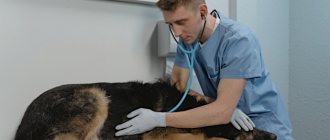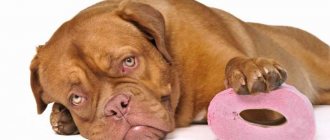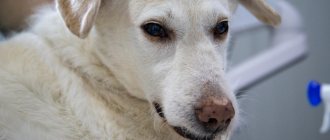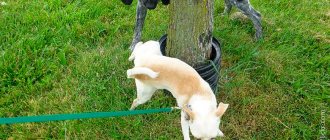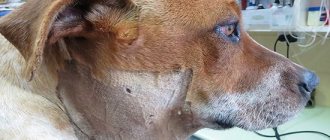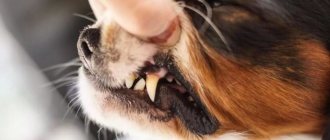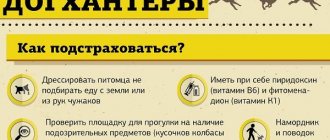Dogs have a delicate and sensitive digestive system that reacts strongly to any changes - to poor quality food, sudden changes in food, to a bone with dirt that the animal can pick up on the street, as well as to the ingestion of a foreign body.
As a result, unpleasant symptoms may appear, including bloody discharge in the stool. If your dog has bloody diarrhea, then in these cases you should immediately contact a veterinarian so that he can conduct an examination and determine the cause of this sign.
Why does bloody diarrhea appear in dogs?
Blood or bloody diarrhea from a dog's anus can appear for various reasons, but the most common of them include a foreign object entering the stomach, severe poisoning, viral infections, severe helminth infestation, intestinal obstruction, the presence of tumors, and even rabies. To recognize a specific problem, it is important to know about the most characteristic symptoms in each individual case.
Entry of a foreign object
For various reasons, dogs may well swallow inedible objects, often during play or as a result of a perversion of appetite. Often these products have sharp edges, so as they move through the esophagus or stomach, they damage the inner lining of the organ, causing an inflammatory process or even tissue necrosis. Usually all this is accompanied by the release of blood, with its further release out in the form of scarlet or red liquid stool.
Streaks of blood in the stool can also appear when the stomach is blocked with plastic bags, threads and bones, which makes it impossible for the normal passage of food and often injures the organs of the digestive system. Why the stomach is clogged can only be said after a full diagnostic examination, but often to eliminate bloody diarrhea it is necessary to remove the foreign body surgically.
Did you know? The record for longevity among dogs belongs to a mixed terrier named Max. He entered the Guinness Book of Records in the 30th year of his life and died in 2013.
Poisoning
Impurities of blood in a dog's stool (sometimes with mucus particles) may also indicate that the pet is poisoned, for example, by food scraps picked up on the street or household chemicals. Once in the intestines and stomach, aggressive substances begin to destroy their mucous membrane, after which the dog begins to diarrhea and within a day can look very lethargic and painful. It is likely that the owner will not even be able to determine what exactly the dog was poisoned with, but it is unlikely that it will be possible to do without medical help.
Infections
Viral infectious diseases are another common cause of blood in the stool of a domestic dog. For example, coronavirus and parvovirus enteritis are widespread among unvaccinated animals and may well lead to such consequences. In the latter case, in addition to bloody impurities in the animal’s stool, there is vomiting, lethargy, lack of appetite and increased body temperature, not to mention the sharp unpleasant odor of feces. Without timely treatment, many puppies and young dogs die, so in order to protect yourself from such problems, it is not recommended to buy babies at poultry markets, where they are most often already infected with helminths and may have a predisposition to certain ailments.
Infection with worms
Infection of a dog with worms can occur as a result of eating thermally unprocessed meat, raw fish, or through contact with waste products of sick relatives. In addition to streaks of blood in the feces, helminthic infestation can manifest itself as black diarrhea and a general depressed state of the pet. Accumulating in the organs of the digestive system, helminths damage the mucous membrane and its capillaries, which causes minor bleeding.
Important! When infected with worms, blood clots are not constantly found in the stool. They may be present during one bowel movement, but on subsequent days the feces look almost normal.
Rabies
The atypical form of this viral disease causes irreversible changes in the dog’s nervous system, largely changing its usual behavior. Infection of a healthy pet usually occurs through the bite of a sick dog or the entry of its saliva into the body, but in any case, due to the similarity of symptoms with gastritis and enteritis, it is not immediately possible to determine the true cause of bloody diarrhea and severe exhaustion of the pet.
Additional symptoms of the disease will be severe weight loss of the animal, an increase in its body temperature, refusal to eat and a pathological craving for inedible objects. Further development of the disease leads to impaired orientation in space, fearfulness and aggressiveness. Death of an infected individual occurs in 100% of cases, so the main thing is to protect people and other pets from contact with it. If a person does come into contact with a rabid dog, it is worth consulting a doctor as soon as possible and undergoing a course of anti-rabies therapy.
Intestinal obstruction
Intestinal obstruction in dogs is explained both by the development of certain ailments of the gastrointestinal tract and by the ingestion of a foreign object blocking the lumen of the colon. If the blood released from the anus is scarlet in color, the lower part of the large intestine is most likely affected, and if impurities are released along with tarry stools, it is worth looking for disorders in the upper parts of the gastrointestinal tract: the stomach or small intestine.
Additional symptoms of obstruction will be:
- frequent vomiting, but resumption of appetite almost immediately after it;
- reduction of feces;
- pain in the abdominal cavity, which causes discomfort in the dog even when lightly touching the stomach;
- unnatural position of the animal’s body, when the pet seems to pull its stomach under itself and arch its back;
- increase in abdominal volume;
- decrease in body temperature.
The simultaneous manifestation of all the symptoms of intestinal obstruction at once is not at all necessary, but if, in addition to bloody diarrhea, at least several of them are diagnosed, it is worth making sure that this pathology is absent.
Hemorrhagic gastroenteritis
Hemorrhagic gastroenteritis is an acute disorder in the canine body, characterized not only by bloody diarrhea, but also by severe vomiting. Large, loose stools are usually bright red in color and are often the most alarming clinical sign. Among the accompanying symptoms of the disease are loss of appetite, often with a complete refusal to eat, lethargy and increased fatigue of the animal, as well as an increase in body temperature.
Hemorrhagic gastroenteritis can be diagnosed in dogs of any breed and age, and the main predisposing factors are frequent stress, excessive excitement, intestinal parasites and the presence of bacterial diseases in the pet. It is also worth paying increased attention to the dog’s diet, preventing it from consuming non-food products or those that are radically different from the usual menu.
Important! The dog's body is not able to form immunity to this disease. Therefore, dogs that have already been ill can very easily suffer from it again, and in a very short time.
Cancerous tumors
Pathological neoplasms in the intestine often close its lumen and can cause food obstruction. The tumor is capable of growing and changing its shape, and malignant types can also leave metastases in neighboring organs. Introduction of any neoplasm into the mucous membrane and deep layers of intestinal tissue threatens damage to blood vessels and, as a result, the release of blood into the feces. If the tumor is large, it can lead to rupture of the intestinal walls, thereby causing heavy bleeding.
Vomiting and other accompanying symptoms indicating a pathological process
When the puppy empties loose stool with scarlet streaks or droplets, but at the same time behaves quite actively and cheerfully, eats, drinks in moderation, and plays, the owner does not have to worry too much: soon the pet’s digestion will normalize. However, it happens that long before the appearance of this frightening symptom, the dog appears other disturbing signs of a pathological condition:
- Vomit. This symptom often accompanies various intestinal disorders, including poisoning, infections, and hemorrhagic colitis. The dog also vomits when there is an intestinal obstruction. If diarrhea with mucus and blood is accompanied by vomiting, this is an alarming sign.
- Rectal prolapse. With this pathology, bloody diarrhea may indicate damage to the hemorrhoid. There will be a lot of blood in the stool, and it will be bright red. A dog with this disorder should be taken to the vet immediately because surgery may be necessary.
- Refusal to eat. The animal does not eat because it has no appetite, is sick or has a stomach ache. This indicates the presence of malfunctions in the entire digestive system and the weakening of the animal’s immunity.
- Photophobia. A pet with distemper not only vomits blood and foam, but is also afraid of light. This symptom also occurs in dogs suffering from rabies.
- Fever. When the body temperature rises, animals shudder in the same way as humans. Chills indicate the activity of the dog’s immune system, which is reacting to some kind of infection. An increase in body temperature in dogs is often accompanied by distemper, parvovirus enteritis, and various intestinal disorders of a bacterial or viral nature.
How to help a dog at home
To help your dog cope with the problem, it is best to immediately contact a veterinarian and use the treatment regimen prescribed by him. However, immediately when a problem is discovered, at home it is worth putting the animal on a starvation diet for 24 hours, leaving only plenty of water to drink. To avoid dehydration if the animal refuses to drink on its own, it should be force-fed by pouring liquid into the mouth using a large syringe without a needle. To stop diarrhea, you can give Smecta, but it will not stop the blood. It is important to do everything quickly, with the obligatory timely contact with a veterinarian.
Prevention
- Do not allow the animal to eat inedible food, expired/spoiled products, do not allow the dog to “pick up” anything on the street, especially in trash cans.
- Vaccinate and vaccinate the animal in a timely manner.
- Give antibiotics and other drugs that cause diarrhea only under the supervision of a specialist.
- Monitor your general condition.
- Provide your four-legged dog with a complete, balanced diet.
How is the diagnosis carried out?
The first stage on the path to effectively eliminating the existing problem is a correctly performed diagnosis, the methods of which are determined by the veterinarian after a visual examination of the animal and collection of anamnesis.
From laboratory tests, the most common when bloody diarrhea appears are the following:
- A general blood test, the results of which will help confirm or refute posthemorrhagic anemia, neutrophilic or lymphocytic leukocytosis and increased erythrocyte sedimentation rate. All this will help to find out about the presence of infection and inflammatory process in the body.
- Blood chemistry. With its help, a study of the renal and hepatic complex of elements is carried out, primarily creatinine, urea, liver enzymes ALT and AST.
- Stool analysis to determine helminth eggs or adult parasites.
- Virological blood test, enzyme immunoassay or polymerase chain reaction, designed to determine the causative agent of the infectious process in the body.
- Instrumental research methods will be a little more informative in determining the specific cause of the appearance of blood in the stool, in particular:
- Gastroscopy and colonoscopy (endoscopic group studies), which help determine the specific source of bleeding, in particular when cancer is suspected.
- X-ray examination (contrast or plain X-ray). Like the previous method, it helps to accurately determine the location of the lesion.
- Ultrasound examination of the abdominal organs. Using appropriate equipment, the doctor can assess the condition of all internal organs and determine the presence of free fluid in the abdominal cavity.
Did you know? The most famous fat dog, included in the Guinness Book of Records, is a border collie named Cassie. At the age of 7 years, she weighed 58 kg, while the norm for representatives of this breed is considered to be no more than 22.5 kg.
The results of several studies together help to create a holistic picture of what is happening and select the most optimal treatment for each individual dog, taking into account the concomitant diseases found in it.
Diagnostic methods
To accurately determine the reason why a dog is sick, it is not enough for a veterinarian to examine the animal. It is also necessary to conduct a comprehensive examination, including the following diagnostic procedures:
- Ultrasound of the liver, pancreas, intestines;
- radiography of the abdominal organs;
- blood test for biochemistry;
- endoscopy;
- urine test.
Only a series of studies will allow the veterinarian to get a complete picture of the patient’s condition and understand why he got sick. In severe cases, studies are carried out urgently.
Treatment of diseases that manifest as bloody diarrhea
Often, the causes of bloody diarrhea in a dog are eliminated with the help of medications, although in some cases it is necessary to resort to surgical removal of the root cause of the disorder. Sometimes folk remedies are a good addition to the main therapy, but in any case it is worth knowing about the features of each specific treatment regimen for red stool.
Medications
Treatment of bloody diarrhea in dogs begins only after an accurate determination of the cause of its occurrence, therefore, depending on the specific problem, the following medications are chosen to eliminate it:
- If helminthiasis is the reason for the liquefaction and redness of the stool, you should turn your attention to anthelmintic drugs, which include Dirofen, Vermox, Helminthal. The dosage and frequency of administration of each of them is prescribed by the doctor, taking into account the complexity of the case and the weight of the dog.
- To stop bleeding, I use homostatic medications, which include aminocaproic acid, calcium chloride and vikasol.
- In case of severe poisoning that requires intensive treatment, the animal is prescribed a course of drips with saline solution to restore fluid loss, antibiotics to combat infectious diseases and probiotics, which restore the intestinal microflora after antibacterial therapy. Drugs such as Levomecitin, Enterosept, and Furazolidone help eliminate intestinal infections.
- In the fight against viral diseases of the gastrointestinal tract, immunostimulating substances and vitamin complexes are used.
- A tumor or a foreign object swallowed by a dog can only be removed surgically. After surgery to remove a malignant tumor, the dog is additionally prescribed a course of chemotherapy or special radiation to prevent re-growth of the tumor due to metastases remaining in the gastrointestinal tract.
At home, to stop diarrhea in a dog caused by food poisoning, the owner can use the well-known medicine “Loperamide”, and the well-known “Regidron” is perfect for restoring the water-salt balance of the body. It effectively relieves all symptoms of dehydration caused by diarrhea. If an increase in body temperature is added to an upset stomach, then antipyretic drugs (for example, Analgin or No-shpu) are used for symptomatic treatment.
Important! If standard means fail to stop bloody diarrhea within 24 hours, then the cause of its occurrence is not trivial food poisoning and urgent medical attention is required. Every day of delay in contacting a veterinarian threatens a significant deterioration in the pet’s health, and in some cases even death.
Folk remedies
It is better not to use traditional medicine recipes without first consulting a veterinarian, otherwise there is a serious possibility of only aggravating the situation. Typically, the following remedies are effective for gastrointestinal problems:
- Chamomile decoction acts as a natural antiseptic and antispasmodic. For diarrhea, take the medicine 15–20 ml 3–5 times a day.
- Oak bark decoction. The finished liquid has astringent properties, which makes it possible to stop diarrhea and normalize stool. Reception rate: 1 tbsp. spoon twice a day.
- St. John's wort infusion. Like the previous medicine, this drink has astringent properties, and to combat diarrhea in an adult dog, it is given 1 tablespoon of the drug 1-2 times a day.
When choosing a particular herb for treatment, the dog owner should not forget about a possible allergic reaction to its components. For this reason, it is recommended to start dispensing decoctions and infusions with a teaspoon, and if after a day there is no deterioration in health, then proceed to the dosages indicated in the recipe.
How to feed your dog during recovery
The animal’s nutrition during the rehabilitation period plays a primary role in the speed of all recovery processes in the body. Since the organs of the gastrointestinal tract are the target of damage, it is logical that all food should be easily digestible, without irritating the already damaged mucous membrane of the esophagus and stomach.
On the first day of the appearance of bloody diarrhea, the dog is not fed at all, but after a day you can give it dietary products in liquid form: for example, rice water, which has worked well with any diet.
As soon as the diarrhea stops and the pet becomes more active, he is offered rice cooked in chicken broth. At the beginning, portions should be very small (no more than two tablespoons), but the frequency of feeding usually reaches 5-6 times a day. On the second day, portions are increased, maintaining the frequency of feedings.
2 days after the cessation of bloody diarrhea, after consulting with a veterinarian, a little kefir, fermented baked milk or any other fermented milk product is introduced into the diet, and another day later it is allowed to give the pet a boiled egg, boiled chicken breast or beef, preferably cut into small pieces.
We recommend reading about the causes and treatment of diarrhea with mucus in dogs.
In the case where the cause of bloody diarrhea turned out to be a tumor and it had to be removed urgently, the starvation diet can extend for 2-3 days from the moment of surgery. All this time, the dog is administered nutrients intravenously or, with the permission of the doctor, is fed low-fat broths. Throughout the recovery period, it is important to give your pet only fresh food, just like at other times.
Diet for diarrhea
Diet is one of the components of treatment. Since with any diarrhea there is irritation (and often severe inflammation) of the intestinal mucosa, food should be as gentle and easily digestible as possible. For diarrhea it is recommended:
- drink more (drinks at room temperature, warm), the preferred drinks are simple drinking water, water-salt mixtures, warm tea, weak jelly, astringent and enveloping herbal teas and infusions. Alcohol, milk, fruit juices, carbonated drinks should be avoided;
- do not eat if you have no appetite (this is a protective reaction of the body);
- When you have an appetite, you can start with secondary broths, oatmeal or rice porridge (in water), dried white bread, mashed potatoes, boiled lean meat (a little, pureed). Then you can try boiled and baked vegetables and fruits. Food should be semi-liquid, homogeneous, it should be taken often and little by little;
- Until stool is completely normalized (and preferably for some time after), fresh fruits and vegetables, as well as alcohol, fatty, spicy and fried foods should be avoided.
What are the dangers of loose stool mixed with blood?
Any disorder in a dog’s body should alert its owner, especially if it is accompanied by the appearance of blood and a general depressed state of the pet. Bloody diarrhea is often a sign of a malignant tumor or a foreign body stuck in the intestine, which means that the sooner the operation is performed, the greater the dog’s chances of continuing to live. Viral and infectious diseases can also be fatal, so do not underestimate them either.
A deterioration in well-being and a change in normal behavior against the background of the possible death of a pet does not seem so dangerous, but do not forget that the animal should live a full life and not suffer from pain.
What are the signs of blood in stool?
There are several ways to determine the presence of blood in your pet’s stool, among which the simplest is a characteristic change in the color of the stool:
- Black may indicate the presence of digested blood, under the influence of which the bowel movements have a tar-like consistency called “melena” and means bleeding of the upper gastrointestinal tract;
- Scarlet is a clear sign of bleeding of the large intestine, therefore, without having time to be exposed to enzymes, the blood is released out unchanged
Preventive actions
The difficulty in preventing diarrhea lies in the fact that this change occurs in many diseases of a wide variety of etiologies. Therefore, the main method is to create optimal feeding and maintenance conditions. Only high-quality products appropriate for the species should be given for food - the dog should not eat only cereals and bones; make meat, offal, dairy products and vegetables the basis of the diet.
If nausea occurs after giving food, then this product should be discarded. Dogs react especially sharply to peppery and salty foods and sweets. Although pets like these foods, their bodies cannot tolerate them and react with intestinal inflammation.
Owners should be very careful when treating and preventing diseases. Many medications cause intoxication, and vaccines used on a weakened body provoke infectious enteritis. Therefore, treatments against parasites, vaccinations and therapeutic measures must be carried out by specialists or under their supervision.
Treatment of bleeding from the anus
Only a veterinarian can diagnose the cause of blood in feces.
Your pet should be examined immediately after red discharge appears in the stool.
Antiviral antibiotics are used to treat diseases caused by infections. After such antibiotics, it is recommended to take a course of the drug, which will restore the natural intestinal microflora and strengthen the dog’s immunity.
Getting rid of worms will be ensured by means that kill parasites inside the intestines. Your veterinarian will help you prescribe anthelmintic medications correctly.
If the body becomes dehydrated, it is necessary to give the dog access to fresh water and immediately contact a veterinary clinic.
Having identified the disease that caused the bleeding, there is a chance to cure the pet, but treatment should only occur under the supervision of a veterinarian.
Amateur activities and treatment with traditional methods can be fraught with consequences and cost the dog’s life.
There is a diet for a pet that is undergoing treatment. It is necessary to exclude hard bones from the dog’s diet, which can injure the stomach; products containing high acidity; food that can irritate the walls of the stomach or intestines.
Therapy for rectal bleeding involves a high-quality and balanced diet



